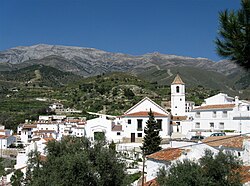
Sedella is a town of 600 people (2019) northwest of the Axarquia, between the Tejeda and Almijara mountain ranges. Sedella enjoys a lush, natural environment where streams, Holm oak and Granados provide plenty of water giving rise to a rich vegetation. Moorish village where the vine was its main crop and it still is an element in its landscape and its economy, producing their fields came fresh, dry or semi-dry may buy bars or private house.
Understand
[edit]Get in
[edit]By bus
[edit]By car
[edit]By plane
[edit]The nearest large airport is in Malaga, which is served by flights from across Europe and America.
By train
[edit]The nearest train station is Malaga which is about 56 km west of Nerja. Easiest way to continue to Nerja from Malaga is by bus from the bus station just across the street, or by car or taxi.
Get around
[edit]See
[edit]- Torreón House: former home of the mayor of the Donceles, the several times mentioned Don Diego Fernández de Córdoba, who was granted the title of Señorío. It preserves a Mudejar style tower with Moorish decoration, open with twin arches on Renaissance columns and decorated with sgraffito of Moorish aesthetics. The interior is covered with four-sided armor and triangle braces.
- Parish Church of San Andrés: the tower ( 16th century ) stands out, with two square horns and one octagonal, topped with a pyramidal spire. Inside the temple there are sculptures from the 17th and 18th centuries, and a monstrance from the 17th.
- Hermitage of the Virgen de la Esperanza: it is located on the outskirts of the town of Sedella, next to the schools, it is part of the remains of the castle of Sedella, from the Arab period. The popular tribute is celebrated together with San Antón. At the entrance is the era, where they used to thresh with mules.
- Roman bridge. From the town you cross a small stone bridge that was possibly built by the Romans.
Do
[edit]- The town celebrates the Fair in honor of the Virgen de la Esperanza Coronada, its patron saint, the first weekend of August. The festive program begins on Friday and the following day the traditional Urban Race of Sedella takes place. The patron is transferred, already in the afternoon, from her hermitage to the church of San Andrés, and after this religious manifestation the festival begins, during which the queen of the festivities is chosen. The neighbours wake up on Sunday with a cheerful flowery target that announces the big day of the fair. At noon the floral offering to the patron takes place, and after mass, the Virgin goes through the streets of the town in procession. Once again they go to the festival and at dawn a fireworks puts a thunderous end to the fair.
- Corpus Christi day is celebrated in a similar way to that of other Malaga towns: from early in the morning, the neighbors strive to erect altars in some streets, which they adorn with the best decorative elements available (bedspreads, flowers, flowerpots, shawls) and Furthermore, they adorn the pavement with plant motifs. The procession, accompanied by a music band, makes a stop at each of the altars, a ritual that the neighbors follow with great devotion.
- The animal festival, San Antón, is made to coincide with the weekend closest to January 17 in order to extend the celebration for at least two days. Thus, on Saturday night a kind of festival is organizsd in which the music band intervenes, which alternates with some flamenco performances. On Sunday, the neighbours take the animals to the pilgrimage, which is presided over by the image of San Antón. One of the central acts of this day is the appointment of the mayordomos (ten in total), who will be in charge of collecting money to pay for the festivities.
- During Holy Week, Our Father Jesús Nazareno and the Virgen de los Dolores go out in procession, on Holy Thursday, which are carried to the hill of Calvario, a place not far from the urban area. On Good Friday, the women are in charge of carrying the Virgen de la Soledad, whose route stands out for the gathering of the public that attends the procession. At midnight on Saturday night a mass is celebrated, and once the religious ceremony is concluded, a ringing of bells gives the signal for the men to prepare their shotguns and fire cartridges of salvos. To this is added the launching of rockets in a kind of fireworks that announces, very loudly, the Resurrection. In this town, sounds play an important role, because, as an anecdote, it should be added that during Good Thursday and Friday, as a sign of mourning. Later, the 'Pedro' is taken out, a doll that is stuffed with straw and burned in the town square, and immediately afterwards we proceed to comply with one of the most unique traditions that this municipality preserves: some neighbors are in charge of going stable by stable to release the beasts, which are led to the town square, or move the pots that they find in the streets to force their owners to go the next morning to the square and collect animals and plants.
Buy
[edit]Eat
[edit]Chivo al ajillo, migas, kid with wine, cabbage and fennel stew, silly donuts, and local wine.
Drink
[edit]Sleep
[edit]- [dead link] Casa Joya Granaino, Sedella. Delightful villa in the mountains of the Costa del Sol. Very tranquil, with stunning views of mountains and sea, and only the sound of birdsong. Pool.
Connect
[edit]As of Dec 2024, Sedella and its approach roads have 4G from Movistar, but only a patchy signal from MasMovil, Orange and Vodafone.
